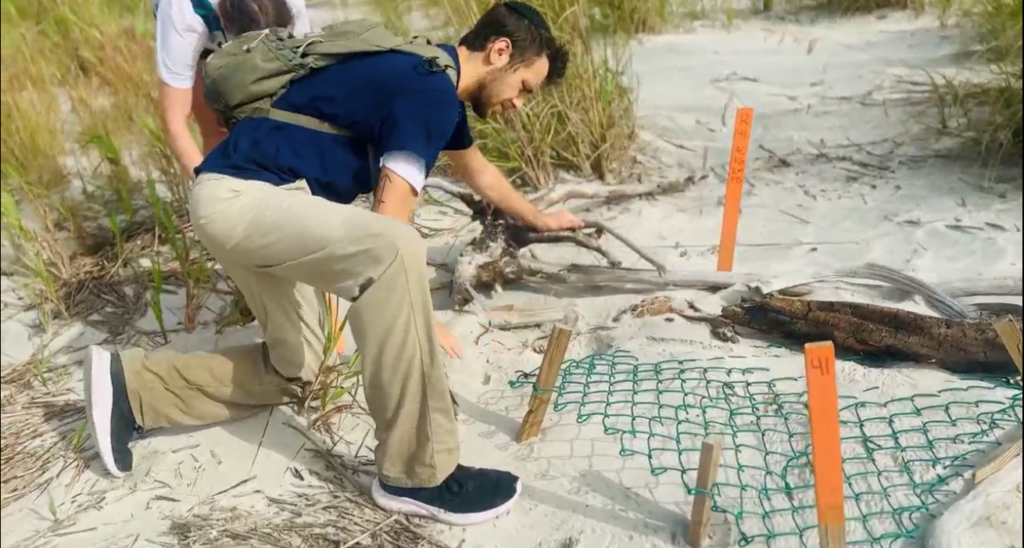
University of South Carolina Beaufort students protect loggerhead sea turtle nests on Pritchards Island. (Provided by USC Beaufort)
BEAUFORT – The University of South Carolina was at risk of losing control of Pritchards Island research site, located off the southern end of the Palmetto State’s coastline.
Now, a year after securing funding in the state budget, the Beaufort campus of South Carolina’s largest college system is back to conducting research on the pristine barrier island, studying wildlife that ranges from loggerhead sea turtles, dolphins and red drum fish to diamondback rattlesnakes, shore birds and several threatened species of bats.
As a result, enrollment in USC Beaufort’s marine biology has surged from six students in 2020 to 116 today, biology professor Kim Ritchie told the SC Daily Gazette, ahead of visit by Gov. Henry McMaster to the Lowcountry university Wednesday.
New tour brings more visitors to Turner House as SC parks agency looks to boost rentals
Atlanta businessman Philip Rhodes donated the undeveloped island, accessible only by boat, to the university in 1982 to use for marine education and research. Then, in 2009, the same year Rhodes died, federal, state and private funding dried up and erosion washed the sand out from under the island’s since-demolished research center as it sat dark for more than a decade.
“It was a pretty successful research program up until funding fell off,” Ritchie said, with professors monitoring turtles, as well as oysters, fiddler crabs, shrimp and other species living in the island’s salt marsh.
The Rhodes family grew frustrated that the university was no longer using the island for its intended purpose and nearly enforced a clause in the deed that would have transferred control to the University of Georgia.
McMaster intervened and last year legislators added $500,000 to the school’s budget to restart the program, including a sea turtle monitoring program that has been volunteer-operated in the college’s absence.
The money has gone to hire a couple more researchers, fund scholarships and purchase kayaks and boats to get to and from the island.
In the last year, researchers and their teams of students have set up cameras on the island to monitor snake and lizard populations. The school also has sensors in the water that pick up sounds from fish and alligators.
They’ve even discovered a never-before studied dolphin population, Ritchie said.
Graduate students from the Netherlands came as part of a study of sand dune vegetation up and down the East Coast and how those plants can help slow erosion, Ritchie added.
And just last week, the college put out acoustic recorders for bats. In that time, the students have already found several species of bats that are at risk of becoming endangered.

The island, untouched by the erosion controls, heavy boat traffic or people building homes that come with much of the state’s fast-growing coastal communities, provides a baseline to compare against more developed places.
“It’s a way to study a natural system that hasn’t been disturbed,” Ritchie said. “The possibilities are limitless.”
In addition to broadening scientists’ understanding, access to Pritchards also is beneficial to students pursuing a career in marine biology.
“Ordinarily, when you start a sea turtle monitoring program, new volunteers don’t get to go anywhere near a sea turtle for a couple years. They have to just watch,” Ritchie said. “We got out there and the students were binding nests and helping babies right away.”
The state dollars have provided students with paid research internships, working with the state Department of Natural Resources before they ever graduate. This can give students an advantage in a fiercely-competitive career field and when they go on to pursue more advanced degrees.
Bringing more faculty with a broader expertise to the school also has expanded student opportunities — from tagging a great white shark as part of Ritchie’s research on microbes beneficial to the marine predator to deep sea exploration using submersibles.
“Everybody wants to be a marine biologist, but you have to have the right connections and the right background,” Ritchie said. “It’s very competitive and this helps them give a leg up.”

